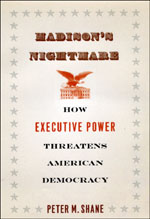The President’s OMB: a lesser-known power grab

From nameless Gitmo detainees to warrantless wiretaps, the abuse of executive power by successive presidents continues to make headlines. Even NPR’s This American Life entered the fray with a piece that aired last weekend about the 1953 U.S. Supreme Court case that created a “state secret privilege” permitting the executive branch to derail normal judicial procedures for cases it claimed would disclose national security secrets. The TAL story reveals that the original 1953 case, in fact, contained no state secrets at all—calling into question not only the government’s motives for moving to dismiss that trial, but undermining the legal basis for the string of cases shut down since—up through the Bush administrations and, unfortunately, the current administration as well.
If this were not enough to concern the ordinary citizen, Peter M. Shane, professor of law at Ohio State University and author of the new book, Madison’s Nightmare: How Executive Power Threatens American Democracy argues in a recent article for George Mason University’s History News Network that the most systematic White House power grab has garnered much less publicity.
Over the past thirty years, Shane argues, the White House has taken increasing control over “domestic rulemaking activity by administrative agencies”—agencies responsible for regulating everything from the air we breathe to discrimination in schools and entitlements to health care— by subjecting them to intensive scrutiny by the president’s Office of Management and Budget. Along with torture, domestic surveillance, and executive secrecy—which Shane also discusses in his book—he sees rulemaking by the executive branch as a significant threat. Shane writes:
The move towards centralization of policy control in OMB should worry Americans for three reasons. First, a tightly controlled bureaucracy is actually less responsive to public sentiment than a bureaucracy in which administrators enjoy some room for independent judgment. This seems counterintuitive because we elect presidents, but not bureaucrats. The problem, however, is that the President is unlikely to reflect the views of the median voter on each and every issue of significant public concern. Because the President chooses agency heads, they will all share his general policy outlook, but each agency head is somewhat more inclined than the President to respect the median voter’s view on the particular issues that his or her specific agency addresses.
Second, the system is potentially less accountable to the public. The more decision making is concentrated in the White House, the easier it becomes to use executive privilege as a shield against disclosure of the decision making process. To be fair, recent Presidents have taken some significant steps to make White House regulatory review more open and transparent than it was in the 1980s, but the potential for changing course towards more secrecy is always present.
Third, the system adds months of delay to the process of issuing new regulations. As I detail in Madison’s Nightmare, it has never been demonstrated that the reduction in regulatory costs produced by White House review has adequately compensated for the value of benefits foregone by delaying new health, safety and environmental regulations for periods often lasting six months or longer.
Shane concludes:
I wrote Madison’s Nightmare partly in the hope of explaining persuasively … how aggressive presidentialism undermines good governance. Much of the book deals with the dramatic questions of torture, domestic surveillance, and executive secrecy that are so often in the news. I hope that the book also brings at least some greater attention to the centralization of presidential policy making control, which deserves far more public attention and debate than it has seen since its inception.
Read the complete article on the History News Network and read an excerpt from the book.